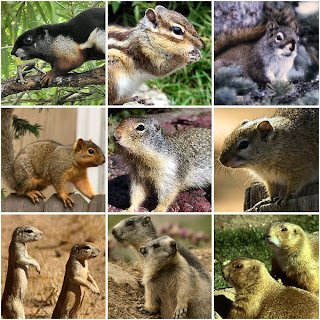Amazing Squirrel Facts
Amazing Squirrel Facts
Image source: http://creativecommons.org/licenses/by/3.0/deed.en
1. Squirrels are the most active in late winter, when the mating season begins. The males will chase females, as well as chase off other suitors. This ritual of chasing occurs through the trees at top speed, while they perform some of the most breathtaking acrobatics imaginable.
2. Squirrels are usually born in the early spring. The average litter consists of four. This varies with climate and location. A second litter can occur in mid summer, if there is an adequate food supply.
3. During winter storms, or severe cold, the squirrel may not leave the nest for days.But, the tree squirrel does not hibernate!
4. A squirrel's brain is about the size of a walnut.
5. A squirrel's teeth grow continuously. Their incisors will grow six inches per year, but stay short due to the constant wear they receive.
6. There are an astonishing number of squirrels worldwide, and many are strikingly attractive animals.
7. In North America, there are several species that are regarded as "tree" squirrels, contrasting with an even greater variety of "ground" squirrels. Tree squirrels are found throughout most of the United States-except the treeless Great Plains and Great Basin areas -and into southern Canada.
8. The fox squirrel (Sciurus niger) and eastern (S. carolinensis) and western (S. griseus) gray squirrels are usually the species involved in homeowner conflicts. Of course, squirrels also have many engaging and fascinating behavioral traits that endear them to us, and make squirrel watching an educational and enriching experience.
9. The eastern gray squirrel measures 8 to 10 inches and has a bushy tail that's almost as long. This squirrel can be highly varied in coloration, ranging from a rufous tint to almost pure white, or even all dark or black.
10. The western gray squirrel is a little longer and heavier than his eastern cousin, while the fox squirrel is the biggest of all-as long as 15 inches with a tail almost as long, and weighing up to three pounds.
11. The squirrel diet varies with the seasons and the availability of plant material (such as nuts, fruits, flowers, and plant buds) that almost entirely makes up the animal's larder. Squirrels also occasionally eat bird eggs or nestlings, and may even pounce on small birds at feeders-much to the dismay of human witnesses who assume that squirrels are passive vegetarians.
12. Squirrels are fascinating animals to watch, photograph, and study. They make themselves available for observation in ways that few other animals do, and they have a rich and complex repertoire of behaviors. For those willing to patiently watch and learn, squirrels have a lot to offer.
13. Red Squirrels have four fingers and two toes on each paw.
14. It is thought that the Red Squirrel made their way to the British Isles from mainland Europe at the end of the last Ice Age, approximately 10,000 years ago!
15. Squirrels do not hibernate, but bury plentiful supplies of seeds and nuts in the ground to eat in the winter.
1`6. Red and Grey Squirrels cannot breed together.
17. Grey Squirrels transmit the deadly squirrel pox virus to the Reds. Greys are immune and are only carriers.
18. Young squirrels are called kittens or kits. They are blind for the first 3 to 4 weeks of life and are born without hair and teeth!
19. Squirrels live in twiggy nests called dreys, situated mainly in the trees. This prevents attacks from ground predators like foxes.
20. The Latin name is Sciurus Vulgaris.
21. Contrary to what its name suggests, the flying squirrel cannot fly. Instead, it glides with two furry membranes, called patagia, loosely stretched between its wrists and ankles. The membranes act as an parachute to support the squirrel while jumping from tree to tree.
22. Depending on the wind and takeoff height, the flying squirrel can glide for 50 metres or more.
23. Red squirrels are not always red in colour! - They can also be brown, almost black, or even quite grey, and can become blonde due to bleaching by the summer sunlight
24. They can be either right or left handed while they eat a pine cone!
25. Squirrels moult their coat twice a year, once after winter to provide a thin coat for summer, and then in the late summer to provide a thicker and warmer coat before the colder winter weather sets in .
26. They have four fingers on each hand and five toes on each foot .
27. Red squirrels can live to six years of age
28. Squirrels are very athletic and can hang upside down!
29. And they can swim!
30. They lose their distinctive ear tufts once a year, when they moult in late autumn.



Comments
Post a Comment